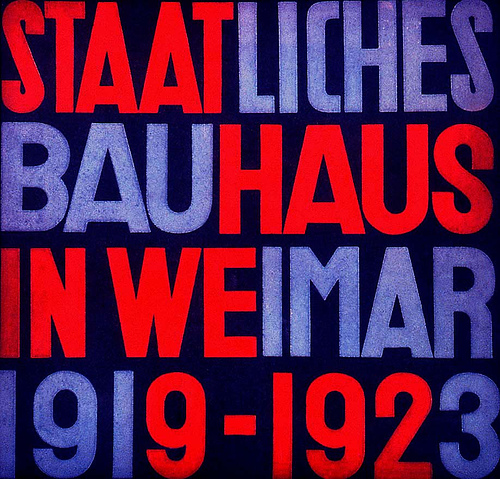Bauhaus and the “Modern” or “International” Style
The Bauhaus school was established in 1919 in Dessau, Germany by a group of architects, engineers, and artists led by Walter Gropius. The ideals of this group were social and political as well as aesthetic. They sought solutions for the problems faced by the working classes in the depression years of Post World War I Germany. Their concerns included urban planning, housing, and the development of high-quality, utilitarian mass production of consumer goods.
A unique feature of their program was the melding of handicraft and industrial production methods. Crafts were thought to be the necessary first step in the training of engineers, architects and industrial designers. In this they differed from the theoreticians of the Arts and Crafts movement, who resisted the use of industrial methods and materials; yet the Bauhaus designers shared the Arts and Crafts veneration of the hand crafts. All engineering and design students took craft courses as well as painting, drawing, and theoretical studies in design and color.
The design style of the Bauhaus group owed a great deal to the de Stijl group, some of whom joined the school as teachers. The ideal of form following function was also emphasized, emphasizing the honest and direct use of materials as the most “functional” way to design. The result was spare, rectilinear forms- in architecture, for example, the structural components of steel, glass, concrete, and other industrial materials were to be used directly and honestly, without imitative form.
The Bauhaus style and teaching methods would become very influential in the teaching of design throughout Europe and the United States, since the teachers emigrated to other universities and design schools in other countries when the Bauhaus was closed by Hitler in 1933. This link will take you to a selection of works by Bauhaus artists and designers. By the outbreak of World War II most were in the United States teaching in major institutions, where they would influence a whole generation of artists and designers. To this day, Bauhaus methods strongly influence the teaching of design in many schools.
Among the most important figures in the Bauhaus school are the architects Walter Gropius , designer of the Pan Am Building in New York; Mies van der Rohe, who designed the modernist classic, the Barcelona chair, and a number of important buildings as well. Among the artists associated with the Bauhaus are Wassily Kandinsky, Paul Klee, Joseph Albers, and Johannes Itten, all of whom published and taught their philosophies of art and design.
Following World War II the style broadened into what became known as the international style, or modern style . The pure form and honest use of materials continued to define architecture and interior design following World War II. However, some designers began to explore the broader structural design potential of industrial materials, and broke with the strict rectilinear forms of the pre-war era.
Among the architects associated with the international style are Le Corbusier, Eero Saarinen, and Marcel Breuer.
Source: Art, Design and Visual Thinking
![]()
Hmm, I think that I need to teach this class a little bit about the history of contemporary type styles and this is a good place to start.
Children, Helvetica did not come onto the type market until 1957, designed by Max Miedinger and as I remember, it was originally called Haas New Grotesk, based on Akidenz Grotesk, a san serif designed in 1896 (and still used today in various versions). It was a product of the Haas typefoundry, a Swiss company, but was later picked up by another foundry and named Helvetica. It came out in the US around 1961, and the local printing company just bought the face in 8, 10, and 12 point cast type and that was when I was first introduced to it. I worked with a graphic designer who also designed type who drew up a large size of Helvetica and then had it printed. I would get an assigment from other designers who needed Helvetica headings and other large type projects. I got a dollar a word for pasting up Helvetica until the foundries came out with a larger selection of Helvetica type sizes.
Not all san serif typefaces that we set tightly were Helvetica. In fact, as you can see by the illustration, setting san serif in a compact format was used much earlier by the Bauhaus, the Constructivists in Russia, DaDa and the Netherlands graphic designers, even going back to the turn of the century. One very popular face from the 1920’s was Futura, designed by Paul Renner and the European version came in 15 versions, but all were more abstract than the one introduced in the US. It was a design face that did not set as well in text as Akindenz Grotesk. The lowercase a looked like the o, and the lowercase t did not always carry well when printed, especially in smaller point sizes but it was great as a display type.
My favorite san serif is Univers, designed by Adrian Frutiger for the Deberney & Peignot foundry in 1956. It has a little more “zing” to it than Helvetica but I did have a difficult time thinking with Frutiger’s numbering system rather than visualizing and ordering by point size. Always change creeping in.
Source: flickr
![]()
Photograph of Walter Gropius, first Bauhaus administrator and a faculty member.
Source: flickr
![]()
This was build in place of the old academy of fine art (Weimarer Malerschule) by Henry Van de Velde, who founded the academy of applied art opposite in a smaller buiding 1907.
In 1919 both schools came together as the Bauhaus under the direction of Walter Gropius. Due to political reasons they had to move on to Dessau in 1925.
An academy of art contiued in Weimar, later called University for architecture and now Bauhaus-Universität Weimar.
Source: flickr
![]()
A break in the weather. Berlin Bauhaus Archive Museum.
Source: flickr
I love the Berlin Bauhaus Archive Museum. when it raining, when it’s pouring.
Source: flickr
Bauhaus Archive Museum, color memorial by Max Bill. Taken in pouring down rain.
Source: flickr
Berlin Bauhaus Archive Museum, built according to plans drawn up by Walter Gropius.
Source: flickr
Dining courtyard of the Berlin Bauhaus Archive Museum.
Source: flickr
![]()
1914
Source: flickr
![]()
1919
Title page for Staatliches Bauhaus Weimar 1919-1923 designed by László Moholy-Nagy.
Source: flickr
Bauhaus Weimar catalog covering the teaching of form and printing workshops 1919-1923.
Source: flickr
Bauhaus Weimar catalog page covering the teaching of form and printing workshops 1919-1923.
Source: flickr
![]()
1922
Bauhaus instructor Oskar Schlemmer’s costume designs “Goldkugel and Taucher” for the “Triadischen Ballet” 1922. I visited the museum in Stuttgart when it was presenting an exhibit of his work where I got to see them in three dimension. Photo from Staatsgalerie Stuttgart.
Source: flickr
Oscar Schlemmer costume design “Der Abstrakte” for the “Triadischen Ballett” 1922. Photograph from the Staatsgaleri Stuttgart.
Source: flickr
Oskar Schlemmer’s costume “Drahftigur” for the “Triadischen Ballett” 1922. Photograph from the Staatsgalerie Stuttgart.
Source: flickr
Oscar Schlemmer Bauhaus ballet costumes. I was most fortunate to visit the museum in Stuttgart, Germany when his ballet costumes were on exhibit.
We take short skirts for granted today, but this costume was designed in the 1920’s.
Source: flickr
![]()
1923/1924
Roots of contemporary lighting. Desk lamp designed by K. J. Jucker and Wilhelm Wagenfeld as a master journeyman project in the Bauhaus Metal Workshop, 1923-24. Bauhaus-Archiv-Darmstadt.
Source: flickr
![]()
1924
Designed by Marianne Brandt 1924. Photograph from the bauhaus archiv museum, Berlin. She also created many exciting photomontages that are not as well known as her metalwork.
Source: flickr
Tea strainer by Wolfgang Tumpel 1924. Photograph from the bauhaus archiv museum, Berlin. I think that there was a whole series of tea strainers.
Source: flickr
Bauhaus Weimer teapot by Kenne,1924. Photograph from bauhaus archiv museum, Berlin.
Source: flickr
![]()
1925
Marcel Breuer chair, one of the very first tubular steel chairs, designed in 1925. Bauhaus archives.
I once read a story about the original tubing that was used for those first chairs. Money was in extremely short supply at the Bauhaus and the school put out a call to local industries to please contribute any materials that they could for the students to work and learn from, so one day a tubing company truck dumped a load of steel tubing on the Bauhaus lawn and drove off. Thankful to get anything to design and work with, Marcel Breuer and his students took the tubing into the Cabinet Workshop and brainstormed for a solution and this is what Marcel came up with, the very first tubular chair. I don’t know if it’s a true story or not but I like to think that it is. I can just see those students lugging in a truckload of pipe and sitting down to figure out some solution for using it, in of all places, the Cabinet Workshop.
“Let’s see, what mask shall I wear today?”
Source: flickr
![]()
1926
Source: flickr
![]()
1927
Chair designed by Marcel Breuer 1927. Photograph from the bauhaus archiv museum, Berlin.
Source: flickr
Woven linen and cotton by Gunta Stolzl, 1927.
Source: flickr
![]()
1928
Another Marcel Breuer chair 1928/29. Photograph from the bauhaus archiv museum, Berlin.
Source: flickr
The book cover On Cubism, designed by Bauhaus instructor Moholy-Nagy 1928.
Source: flickr
Magazine cover designed by Bauhaus instructor Herbert Bayer 1928.
Source: flickr
![]()
1929
I think this was designed by Herbert Bayer 1929.
1929, the year that the U.S. stock market crashed and the Great Depression began.
Source: flickr
![]()
Roots of contemporary lighting. Bauhaus lighting design from the Metal Workshop.
Source: flickr
![]()
Herbert Bayer, Bauhaus typographic layout.
Source: flickr
![]()
After serving in the German army during WWI, Herbert Bayer (born 1900 in Austria) enrolled in an arts and crafts studio, then worked for a designer. In 1921 he studied at the Weimar Bauhaus and then taught there, starting in 1925, teaching typography & advertising effects. Bayer then worked full-time for advertising agency Dorland International and as art director for Vogue magazine.
In 1938 Bayer emigrated to the US and worked in New York until 1946 for such clients as Dorland International, Thompson, Wanamaker’s, and developing exhibitions and general graphic design for large corporations.
In 1946 He moved to Aspen, Colorado and continued as consultant to firms such as Container Corporation of America.
Source: flickr
![]()
Furniture designed by Gerrit Rieveld.
Source: flickr
![]()
German stamp commemorating Bauhaus teacher and artist Joseph Albers.
Source: flickr
German stamp commemorating Bauhaus teacher and artist Moholy-Nagy.
Source: flickr
![]()
Note: Komentar dari kolektor (Marryellen Mcfadden, pengajar desain grafis) - yang terkadang tercantum pada deskripsi masing-masing karya - sengaja tidak dihapus, karena bisa merupakan informasi yang berguna untuk melakukan penelitian yang lebih mendalam.
•••
To be continued.











 1. Nirmana: Elemen-elemen Seni dan Desain | Sadjiman Ebdi Sanyoto
1. Nirmana: Elemen-elemen Seni dan Desain | Sadjiman Ebdi Sanyoto 2. Desain Komunikasi Visual Terpadu | Yongky Safanayong
2. Desain Komunikasi Visual Terpadu | Yongky Safanayong 3. Hurufontipografi | Surianto Rustan
3. Hurufontipografi | Surianto Rustan www.underconsideration.com
www.underconsideration.com

[…] misstrade article is brought to you using rss feeds.Here you will find the best trucking resources for truckers.Money was in extremely short supply at the Bauhaus and the school put out a call to local industries to please contribute any materials that they could for the students to work and learn from, so one day a tubing company truck dumped a … […]
[…] post by Desain Grafis Indonesia Share and Enjoy: These icons link to social bookmarking sites where readers can share and […]
[…] unknown wrote an interesting post today onHere’s a quick excerptCrafts were thought to be the necessary first step in the training of engineers, architects and industrial designers. In this they differed from the theoreticians of the Arts and Crafts movement, who resisted the use of industrial … […]
[…] Here’s another interesting post I read today by Desain Grafis Indonesia […]
[…] January 17th, 2008 You can follow any responses to this entry through the RSS 2.0 feed. Responses are currently closed, but you can trackback from your own site. Safety Employment.Jobs in occupational safety, insurance loss control, health/environmental, etc. The Bauhaus (1919-1933) […]
[…] konsep-konsep seni abstrak Avant Garde lainnya seperti Konstruktivisme, Dada, dan De Stijl, maka Bauhaus juga tidak akan lahir. Padahal konsep Bauhaus sangat vital dalam dunia pendidikan maupun praktek […]
get more info
[…] The Bauhaus (1919-1933) 15.101 views […]